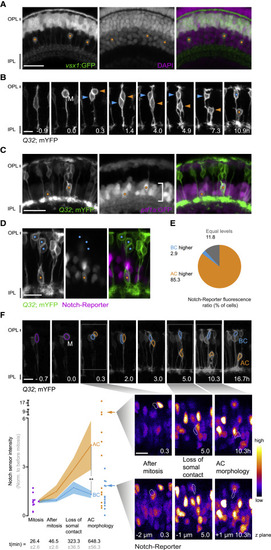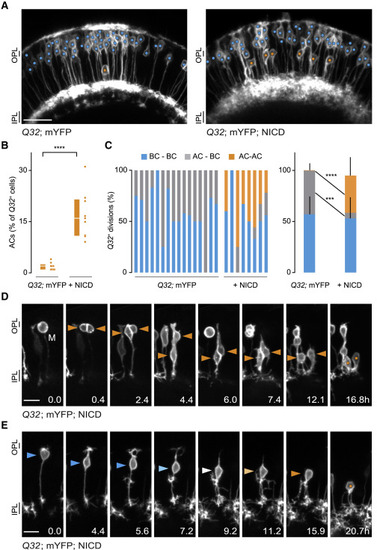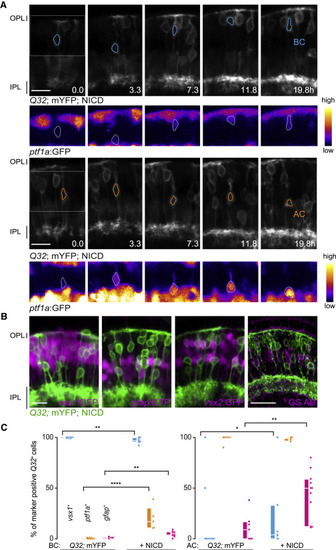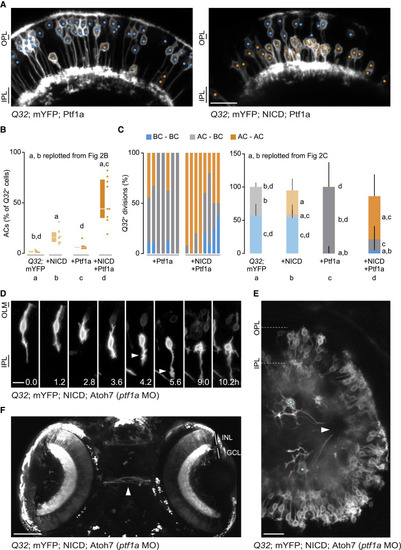- Title
-
Notch-mediated re-specification of neuronal identity during central nervous system development
- Authors
- Engerer, P., Petridou, E., Williams, P.R., Suzuki, S.C., Yoshimatsu, T., Portugues, R., Misgeld, T., Godinho, L.
- Source
- Full text @ Curr. Biol.
|
Figure 1. Vsx1 progenitors generate ACs (A) 3 dpf vsx1:GFP retina with vsx1+ BCs and ACs (orange circles). (B) 2 dpf Q32 progenitor undergoing mitosis (M), generates a BC (cyan arrowhead; circle, final time point) and an AC (orange arrow-head, circle final time-point). (C) 3 dpf WT retina showing ptfa:GFP+ Q32 ACs (orange circles). Ptf1a:GFP labels all ACs (INL, bracket, center panel). Ptf1a-GFP signal bleeds through Q32-YFP channel. (D) 3 dpf retina showing Notch-reporter (tp1:hmgb1mCherry) expression in a Q32 AC (orange circle), but not in surrounding Q32 s BCs (cyan circles). (E) Notch-reporter (tp1:hmgb1mCherry) fluorescence intensity in Q32 ACs and BCs. AC and BC categories were tested against an expected frequency of 50% using a binomial test, p < 0.0001; 30 cells, 10 fish. Four ACs (of 34) displayed equal levels of fluorescence as neighboring BCs. (F) 2 dpf transgenic retina (Q32; mYFP; tp1:H2BmCherry; top grayscale images, gamma adjusted) showing a WT Q32 progenitor (purple outline) generating a BC (cyan) and an AC (orange). Notch-reporter levels in the AC and BC depicted using a Fire LUT (below, right). Notch-reporter intensity levels (means ± SEMs) for 13 Q32 progenitors (8 fish) and their BC (cyan) and AC (orange) daughters (below, left). Times in relation to the time point before mitosis. Significant differences between BC-AC pairs were found when the AC acquired its characteristic morphology (Wilcoxon matched-pairs signed-rank test, p = 0.0061). Scale bars, 20 μm (A and C); 10 μm (B, D, and F). IPL, inner plexiform layer; OPL, outer plexiform layer. See also Figures S1A, S2, and S3A–S3C. |
|
Figure 2. Notch signaling promotes AC fate in the vsx1 lineage (A) 3 dpf retinae from Q32 WT and Q32 NICD. BCs (cyan circles), ACs (orange circles). (B) Proportion of ACs in WT and Q32 NICD. Median and interquartile range (IQR) shown. Q32 WT (21 ACs, 9 fish); Q32 NICD (140 ACs, 9 fish), p < 0.0001, Mann-Whitney U test. (C) Proportion of Q32 divisions in WT and following NICD OE for each fish (left). Collective representation of Q32 divisions, representing median and IQR per group (right). BC-BC: Q32 WT versus NICD, p = 0.5134. AC-BC: Q32 WT versus NICD, p = 0.0004. AC-AC: Q32 WT versus NICD, p < 0.0001. WT: 141 Q32 divisions, 16 fish; Q32 NICD: 44 divisions, 8 fish. Mann-Whitney U test. (D) 2 dpf Q32 NICD retina, showing a mitotic progenitor (M) generating 2 ACs (orange arrowheads; circles, last time point). (E) 2 dpf Q32 NICD retina, showing a BC (cyan arrowhead), transdifferentiating into an AC (orange arrowhead; circle, last time point). Scale bars, 20 μm (A); 10 μm (D and E). See also Figures S1, S3D, and S3E. |
|
Figure 3. Marker expression in re-specified ACs (A) In Q32 NICD, BCs (outlined cyan, upper grayscale panels), express ptf1a:GFP (Fire LUT), albeit at lower levels than in ACs (outlined orange, lower grayscale panels). Ptf1a-GFP signal bleeds through Q32-YFP channel (grayscale panels). (B) Following NICD OE, transdifferentiated Q32 ACs do not express vsx1:GFP but gfap:GFP. Q32 ACs are negative for vsx2:GFP and glutamine synthetase (GS antibody, AB). (C) Percentage of Q32 BCs (left) and ACs (right) expressing vsx1, ptf1a and gfap in WT or Q32 NICD. Median and IQR represented. BCs: vsx1:GFP+: Q32 WT, (1227 BCs, 14 fish) versus NICD, (416 BCs, 7 fish); p = 0.0034. Ptf1a:GFP+: Q32 WT (1,614 BCs, 14 fish) versus NICD (486 BCs, 5 fish); p < 0.0001. Gfap:GFP+: Q32 WT (718 BCs, 7 fish) versus NICD (984 BCs, 11 fish); p = 0.0022. ACs: vsx1:GFP+: Q32 WT (28 ACs, 15 fish) versus Q32 NICD (100 ACs, 7 fish); p = 0.0129. Ptf1a:GFP+: Q32 WT (60 ACs, 13 fish) versus Q32 NICD (124 ACs, 4 fish); p = 0.1206. Gfap:GFP+: Q32 WT (43 ACs, 7 fish) versus Q32 NICD (335 ACs, 11 fish); p = 0.0078. Mann-Whitney U test for pairwise comparisons. Scale bars, 10 μm (A and B). |
|
Figure 4. Notch signaling imparts plasticity to nascent post-mitotic cells (A) 3 dpf retinae from Q32 Ptf1a and Q32 NICD Ptf1a fish. Q32 BCs (cyan circles), ACs (orange circles). (B) Proportion of ACs in Q32 Ptf1a and Q32 NICD Ptf1a represented as median and IQR. Q32 Ptf1a (66 ACs, 9 fish), Q32 NICD Ptf1a (372 ACs, 9 fish). Q32 WT and Q32 NICD originally plotted in Figure 2B. Significant differences found between WT and NICD (p = 0.0003), WT and NICD Ptf1a (p < 0.0001), and Ptf1a and NICD Ptf1a (p = 0.0005), denoted by a (significantly different from Q32 WT), b (from NICD), c (from Ptf1a), or d (from NICD Ptf1a). Kruskal-Wallis and post hoc Dunn’s multiple comparisons test, further adjusted by the Benjamini-Hochberg false discovery rate (FDR) method. (C) Q32 divisions in Q32 Ptf1a and Q32 Ptf1a NICD for each fish (left). Divisions representing median and IQR per group (right). Q32 Ptf1a: 42 divisions, 7 fish; Q32 NICD Ptf1a: 52 divisions, 8 fish. Q32 WT and Q32 NICD originally plotted in Figure 2C. Significant differences were found in BC-BC divisions: WT versus Ptf1a (p = 0.0001), WT versus NICD Ptf1a (p = 0.0004), NICD versus Ptf1a (p = 0.0029), NICD versus NICD Ptf1a (p = 0.0075); AC-BC divisions: WT versus NICD (p = 0.0127), NICD versus Ptf1a (p = 0.0001), Ptf1a versus NICD Ptf1a (p = 0.0034); AC-AC divisions: WT versus NICD (p = 0.0007), WT versus NICD Ptf1a (p < 0.0001), Ptf1a versus NICD Ptf1a (p = 0.0035), denoted as in (B). Kruskal-Wallis and post hoc Dunn’s multiple comparisons test, further adjusted by the Benjamini-Hochberg FDR method. (D) An emerging GC-like cell in a 2-dpf Q32 mYFP NICD Atoh7 retina with ptf1a morpholino (MO). The cell migrates basally, loses its bipolar morphology, and grows out an axon (arrowhead) and apically directed processes. (E) Two Q32 GC-like cells in a 3-dpf transgenic embryo (Q32; mYFP; NICD; Atoh7 and ptf1a MO). Putative axons exit the retina (arrowhead). Gamma adjusted. (F) Dorsal view of a 3-dpf embryo (rostral top, eyes lateral) in which GC-like cells were induced (Q32; mYFP; NICD; Atoh7 and ptf1a MO), showing axons at the chiasm (arrowhead). Gamma adjusted. Scale bars, 20 μm (A); 10 μm (D and E); 100 μm (F). GCL, ganglion cell layer; INL, inner nuclear layer; OLM, outer limiting membrane. See also Figure S4. |




